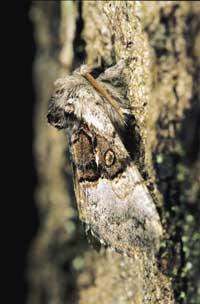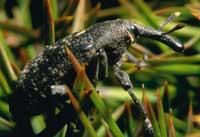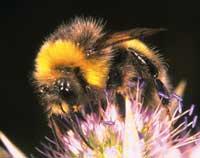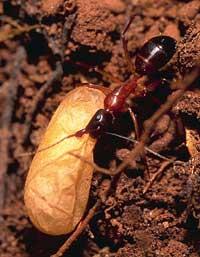Pheromones: the surprising language of smells
1996/04/01 Sarasua Aranberri, Asier - Biologoa Iturria: Elhuyar aldizkaria

However, the signals used in this information exchange can be very varied. Depending on the time, place, animal and message you want to send, different types of signals and communication channels are used for the transmission and reception of information. We work with different organs of feeling. Sometimes hearing is used as a means of communication, sometimes touch, often sight; in most groups, although it is difficult for us to understand it, smell predominates or more specifically communication through chemical signals.
It cannot be said that it is the most useful or better or more developed between these ways of contact. Each type of signal has its advantages and disadvantages and at each moment it will be used as appropriate. For example, in a few seconds you can get a lot of information through the view, but this communication system requires that the distance between sender and receiver is not very large and, having to leave the hideout to send and receive the message, can be dangerous.
Aware of this, many species, like most birds, use acoustic messages to get to know each other, as these signals can be sent from a protected place without fear. On many other occasions messages are sent through touch. It is a very effective form at small distances and is mainly used to express feelings or desires. Birds often move with each other, even when they get home and the dog leaves their faces stuck to the tip, their message is clear. But the problems or limitations of touch communication are also evident: the distance between transmitter and receiver must be very small and it is impossible to send complex and fast messages.
Humans mainly use sight and hearing to communicate with each other. When we want to know what is happening around us, plast!, we think we open our eyes, place our ears upright and realize everything. The truth is that it is very different and we cannot take most of the information that flows through the environment.
Moreover, as in us, sight and hearing are very important, we often forget or find it difficult to think that for most living beings the world is a very different place, full of sweet smells and bad smells. In most groups, animals do not use gestures or sounds to know each other: they use odors. From single-celled microorganisms to mammals through insects, worms or reptiles, chemical communication is very important in almost all groups. Animals are “said” through their desires, fears, situation, age, social hierarchy and thousands of chemical issues. The least part of everyday life is organized and regulated by aromatic chemicals.
The complex world of Feromón
Chemicals used by animals to communicate with each other are called Pheromone. The origin of this word is Greek and comes from Pherein (displace) and the wall (excite), which is what pheromones do. Pheromones are chemicals that are secreted by an animal to communicate something to another (or to several); substances that, upon reaching the receptor, cause a change in physiology or behavior.

Its diversity, complexity and abundance is surprising. If we analyze the molecular level, for example, we find esteres, alcohols, acids, hydrocarbons, etc. between pheromones. As for the measure, there are all kinds, small (5 or 6 carbons) or long (dozens of carbons). They can be light or heavy and consist of a single molecule or a mixture of different molecules. Some are very stable, those who use animals to mark their territories, others are very unstable and short-lived.
How many are volatile or weldable in water and others stable, heavy and insoluble. As you can see, according to the message, the species and the moment, animals can use very different chemicals to relate and through these topics they can express almost everything. We must recognize that communication between human beings is complex and wonderful, but we cannot deny that the world of the hundreds of pheromones that keep the colony of millions of ants in operation with all precision is surprising and admirable.
Over the last 20 years, more than a thousand articles have been published about pheromones and, in the same period, hundreds of pheromones have been found, analyzed and isolated. Given the abundance, it is not possible to delve into all these pages, it is not our goal. To this world as complex as unknown we will make a small review of the main types of pheromones.
Talking to smells

To begin with, we will go to one of the most varied sets among pheromones, the so-called "pickup pheromones". According to their name, they are chemicals that encourage members of the same species to meet in one place. This “meeting” can be convened for different reasons such as feeding, finding a partner or spending the winter together in a warm and appropriate place. Collection pheromones are widely used in insects that live in colonies such as ants or bees, as well as in many other groups of animals. Snakes or many rodents, among others, are collected dozens of them called pheromones collection to spend the mild winter in the same shelter.
The "invitation pheromones" are similar. They are calls that send indicating that an animal has found a suitable place to eat or spawn: “Come, here it is for everyone.” Unlike the previous case, animals only come to eat or spawn the place of sending the message. They are never great meetings: after doing the tasks, they leave.
In some cases, competitors may be difficult and it is convenient to chase away instead of meeting. For example, when food is scarce or when males find it difficult to find breeding females, animals do not produce succulent aromas to attract their friends: in these cases they expel unbearable pheromones that throw them back. These pheromones act as a barrier and animals never exceed this odorous limit. This is the mission of the "dispersion pheromones": to keep the peers away.

Another important group is the “best alarm feromon”. The message transmitted through them is clear and fast: “Look! Risk in the environment.” These pheromones are secreted by animals by detecting fear or danger to warn peers. This function makes them very light and volatile. A good example is found in the world of bees. In the door of the hive are usually the caring bees, normally quiet, observing the displacements of the workers.
When a stranger tries to enter the hive, his behavior changes radically; the vigorous watch, as soon as it detects the danger, enters at full speed into the hive and begins to release pheromones of alarm. Shake the wings and spread the message of danger throughout the hive, warning all its members in a few seconds. Few animals dare to surround thousands of bees to a hive willing to introduce the sting.
Other important pheromones are the “acceptance pheromones”. They are generally heavy and transmitted in direct contact between animals. Animals that live in groups always appear and act as identification cards. Through them each animal expresses its name, age, profession, social category, etc. There are hundreds of examples: lions, wolves, sheep; the dogs we see on the street smelled of each other are being taught the D.N.I.
Despite its importance in most species, it is exceptional among animals living in large colonies. In the case of bees, termites or ants, for example, are the key to keeping the colony going, and through the antennas are always given odor to know who is and what the neighbor says.

The other closest manifestation of Feromón is found in the kitchen of the house, in spring-summer, when we find ants in line and moving antennas following an invisible path for us. Ants follow the imprint of "conductive pheromones." These chemicals are used in groups of hymenoptera (wasps, ants and bees) and isopteros (termites), especially the thousands of species of ants that inhabit the world. When an ant finds food, it marks the way through the conductive pheromones and thus communicates to the entire colony where to go to find food. These pheromones, of course, have to be secret so that the rest of the species do not understand them, on the other hand they are very odorous and, for example, a pheromone milligrams of an ant of Atta texana is enough to make known to its associates the road of 100,000 kilometers.
For animals living in colonies such as ants or bees it is a serious problem to decide what to do with the dead. This has also been solved by pheromones. Surprisingly, after the death of the ants secrete a special pheromone, the so-called "death pheromone", and the rest of the ants perfectly understand the message: “The body must be expelled because it is in the anthill.” It is a very powerful message, and if we throw a small drop of that pheromone on a living ant (also on the queen), they will expel it and it will not be accepted in the group again.
Animals use pheromones to express ownership of a territory. Bears leave the smell on tree trunks and act like wolves, cheetahs or other animals. Through the "territorial pheromones", each animal has its territory and informs others of who the territory is and whether or not they can access it.
Finally, we will analyze the pheromones that are mainly used in almost all groups of animals: “sexual pheromones”. As is known, in animal life there are two main activities: eating (to survive) and having descendents (to transmit their own genes and maintain their own species). And the latter is usually not easy, as the competition is huge. Therefore, in nature there have been numerous messages related to sex, mainly to attract the couple: the bright green of the firefly, the song of the kilki, the colorful tail of the turkey, etc.

And most animals have invented perfumes: delicious and attractive pheromones. When an animal wants to attract its partner, the flashy songs and dances are often not enough and perfumes are used. If you take the smallest drop of the sweetest pheromone, soon hundreds of people will arrive wanting to practice sex. But the function of sexual pheromones is not just to bring the couple closer. They can have many different goals. Some are only used to attract the couple, but many others are used to shout it and make it ready for fertilization (aphrodisiacs); other times pheromones are used to say that the female will not be in the male (already pregnant or not wanting) and in general to give any information related to sex: at what time of the sexual cycle, if they are too young for reproduction, etc.
All of them are just some of the thousands of pheromones that can be found in the complicated and surprising world of chemical communication. Hundreds more are known and probably in the next few years there will be many others. However, these examples are sufficient to see on the one hand the complexity and richness of the world of pheromones and, on the other, to verify that, although it is difficult for us to believe, chemical communication between animals is the most widespread system. In other words, to see that most species of living beings have a totally different picture of the world than we can have.
And humans, what?
Seeing that pheromones are so widespread among all animal species, what can we say about human beings? Do pheromones affect us? And without realizing it, will the odors that reach our nose influence our physiology or behavior? If we have to attend to TV ads, we should say yes. With any perfume we will get the most effective sexual pheromone and it seems that we will be able to conquer as many women or men as we want. And not only that! With these aromas, we also launch hierarchical pheromones or acceptance pheromones, with success, money and power.

As we said, it is a message that the ads usually give, but the truth is totally different, because we still know very little about the influence of pheromones on humans. Throughout evolution, the human being has mainly developed sight and hearing, which has meant a loss of smell that, to this day, we will hardly know 1% of the animals through smell. However, for the most primitive activities, especially in the field of sex, we can still find hints of that lost capacity throughout evolution. An example of this is the monthly cycle of women. Some studies have confirmed that among women who live together, menstruation is often synchronized, which is due to the small glands in the armpits, the apocrine glands. These glands secrete along with the sweat pheromones that synchronize the ruler.
On the other hand, the relationship between perfumes and desires began to work as soon as the human being was born. Long before getting to know Feromón, most Asian and European cultures used the sexual pheromone of deer to make perfumes, the so-called lizard. Although the smell of Musketa is very hard and unpleasant, it is surprising to know that it has been used in many cultures. Is it pure chance or do smells affect us more than we think? If we recognize that it is so and seeing that some smells affect us directly, will it be possible to get that perfect and wonderful perfume that perfumers have sought over the centuries? Will human sexual pheromone ever be discovered? Although I find it quite difficult to be so smelling, just in case it is worth paying attention.

Gai honi buruzko eduki gehiago
Elhuyarrek garatutako teknologia



